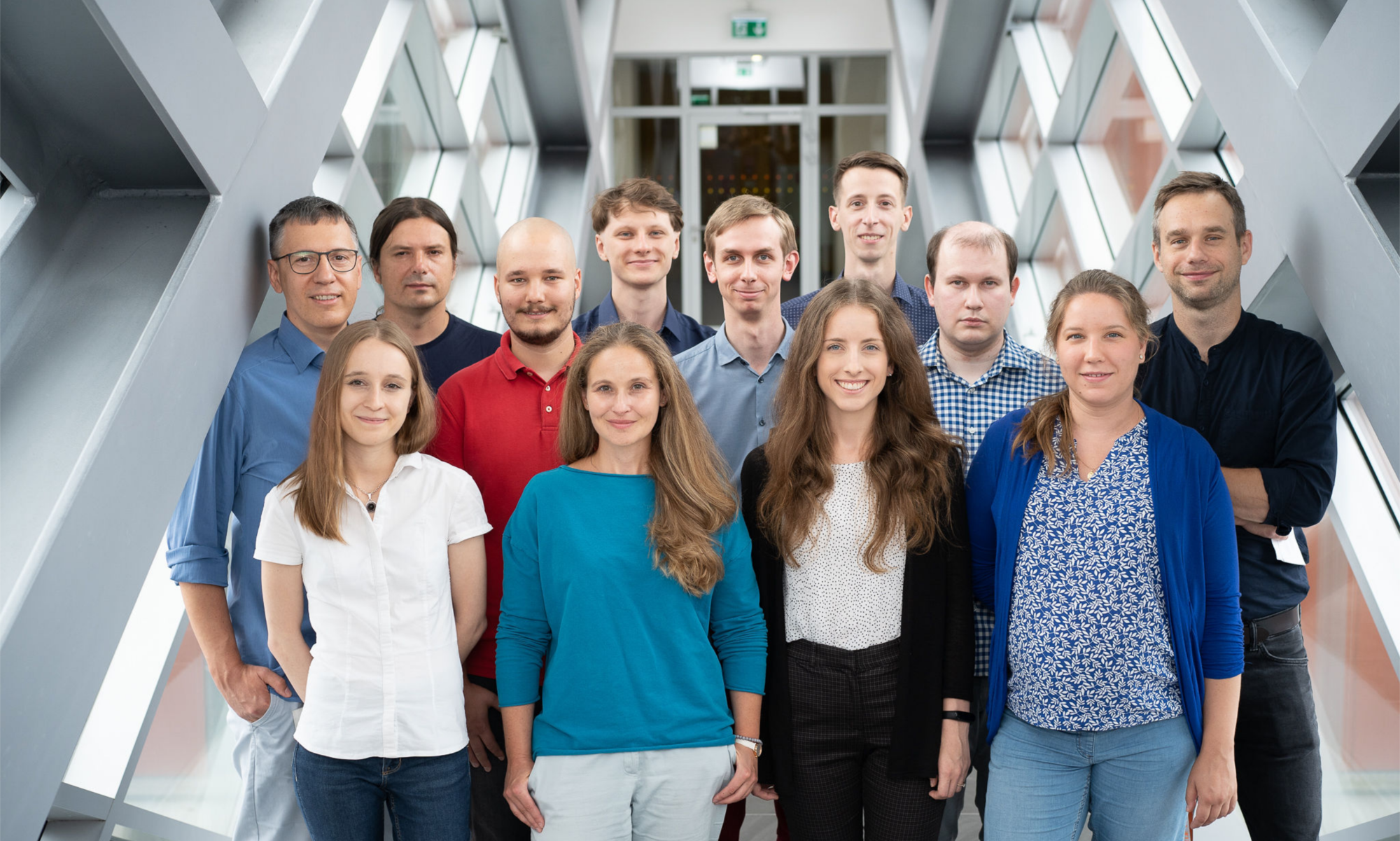Transition metal dichalcogenide monolayers in microcavities
Semiconducting transition metal dichalcogenides (TMDs) such as MoS2, MoSe2, WS2 and WSe2 are a group of materials with much attention in recent years. Their crystal structure resembles those of graphene and consists of strongly covalently-bond two-dimensional sheets with only week van der Waals forces between the layers. Of special interests are single layers of semiconducting TMDs exhibiting direct bandgap and therefore are used as light emitting materials.
We investigate the whole family of TMDS in a specially designed, open microcavity structures. In the so-called strong coupling regime interactions between excitons and cavity photons lead to creation of new mixed light–matter quasiparticles: exciton–polaritons. Our recent achievements demonstrate exciton-polaritons at room temperature, spin selective valley polarization effects and strong coupling regime in multilayer TMDS layers.
Semimagnetic exciton-polariton condensates
Exciton-polaritons are quasi-particles formed by strong coupling of excitons in a quantum well and photons confined in optical cavity. Their bosonic character allows for the formation of a macroscopic quantum state: a non-equilibrium Bose-Einstein condensate. The semi-magnetic polaritons studied in our group form a unique class among polaritons.
The magneto-optical effects in semimagnetic polaritons are especially strong due to magnetic ions such as Mn2+ incorporated into crystal lattice. In external magnetic field magnetic moments of magnetic ions orients and through s,p-d interactions acts on charge carriers as an additional effective magnetic field. We demonstrated in those structures giant Zeeman splitting, spin Meissner effect and the formation of circularly polarized polariton condensates.
Liquid crystal microcavities
Optical cavities allow for localization of electromagnetic field. Typical structures of microcavities contains alternating dielectric or semiconductor layers of different refractive indices with wedged shape allowing for finding resonance with the emitter, as quantum wells.
In our group we developed new kind of structure for investigation of strong coupling at room temperature using as a cavity material liquid crystals (LCs). Their use allow for ease tuning, important to adapt to the cavity resonance with the excitonic mode in the emitter and reaching strong coupling regime. Tunability is possible due to tilting of the anisotropic LC molecules induced by electric field applied to the whole structure. The big advantage of the LC microcavities is the simplicity of operation and the ability to work at room temperature. We investigate LC cavities with entire class of emitters: transition metal dichalcogenides, quantum dots, dyes, perovskites etc.
Spin-orbit coupling in liquid crystal microcavities
Spin-orbit coupling gives rise to many different interesting phenomena. We are focused on the spin-orbit interactions of light in LC optical cavities. This is extremally interesting system because of the tuning, and thus the ability to smoothly change the parameters describing the structure, as dielectric tensor. The rotation of the dielectric tensor leads to a change of TE-TM splitting. This makes LC cavity an interesting system to study optical spin Hall effect (OSHE).
We conducted optical measurements of reflectivity or transmission spectra in real and reciprocal space, which allowed us to examine the tunable optical spin Hall effect. In addition, we observed the optical counterpart of Rashba-Dresselhaus effect known from solid state physics. In the studied system, the spin-orbital interaction for light is observed in the form of oppositely circularly polarized parabolic cavity photon dispersions. For the appropriate angle of rotation, corresponding to the intersection of modes with opposite parity, the cavity modes lose their original linear polarization and create two not concentric, counter-circularly polarized, parabolic dispersion relations.
Exciton-polariton based Neuromorphic photonics
The challenge in developing optical Artificial Neural Networks for neuromorphic computing is the realization of a nonlinear activation function and simultaneously providing ultrafast operation and functions required for networking. In this context, we argue that hybrid light-matter exciton-polaritons with strong interactions appear as an ideal system to emulate ANN node with sub-ns processing abilities.
Since photons are very weakly interacting particles even in specialized nonlinear materials, optical neurons based on pure photons typically require large input power to reach the nonlinear regime, thus limiting their capability in terms of speed or energy efficiency. The strength of exciton-polariton nonlinearity, which originates from exciton-exciton interactions (the Kerr nonlinearity) is several orders of magnitude larger than in typical semiconductor systems outside the strong coupling regime. Polariton interactions already permitted the observation of a wide class of non-linear phenomena such as Josephson oscillations, soliton generation, and optical bistability.
In our laboratory, we investigate nonlinear responses of various types of microcavities under different conditions (pumping regime, different exciton-polariton coupling regimes, etc.) in seek for configuration most suitable for implementation in future optical neuromorphic devices.
We believe that microcavities with exciton-polaritons are the ideal candidate for neuromorphic systems with their hybrid nature providing photons as an information carrier and the ability to manipulate this carrier due to exciton-photon interactions.
Blue phase liquid crystal
Blue phase liquid crystal (BPLC) is a highly ordered liquid crystalline phase based on the structure of double twisted cylinders. Due to the three-dimensional periodicity of the defect structure, these materials show the effect of selective reflection of light and are classified as three-dimensional photonic crystals. The BPLC can be divided into three categories (BP type-I, -II and -III) which occur in a narrow temperature range and differ in the internal order of the liquid crystal molecules.
The main advantage of the BPLC is the easy tuning of optical properties with external stimuli, for example electric and magnetic fields, temperature, light or mechanical forces. Other advantages are fast-speed response, easy fabrication process and macro-optical isotropy. The use of a polymer scaffold that significantly extends temperature stability opened the way for many potential BPLC applications such as blue phase mode LCD, sensing, switching and photonic technology.
The three-dimensional photonic crystal acts as an optical cavity. By using organic (laser dyes) and inorganic (quantum dots) dopants of light emitters, we study phenomena such as lasing and diffraction of visible light (Kossel patterns) in room temperature. Our samples, which are grown in cooperation with the Military Technical Academy, contains large-scale monodomain BPLC, a unique platform adapted to our research.
Theoretical analysis and numerical calculations of light propagation in optical cavities
In our research group, in addition to a wide range of experiments with optical microcavities, we develop analytical models that reflect the exact numerical methods and experimental results.
Optical microcavity can be enriched by the presence of various materials, such as liquid crystals, transition metal dichalcogenides, organic dyes or fluorescent proteins that allow the creation of many fascinating types of interactions between the photons enclosed in the cavity and the excitons formed in the emitter region. The description of such interactions is complicated, therefore, in many cases it is possible to obtain only numerical solutions. Modelling using transfer matrix and Berreman methods is a crucial element of our work because it allows, inter alia, comparison of experimental data and existing theoretical models.
Furthermore, out of numerical part, extremely important is also purely analytical approach, because it gives an insight into the real nature of the phenomena, providing a better understanding of it. Therefore we develop analytical models that perfectly describe experimental results and show beautiful correspondence between the optics of single electromagnetic modes on one side and physics of condensed matter on another.
Broad applications of the optical microcavities, which have been previously proposed by our group, form a foundation of further more complex research, which is currently being intensively carried out. We believe that our hypotheses and models allowing a better understanding of observed phenomena, will open new, still unknown areas in the field of light-matter coupling, and will enable the use of our results for the construction of new light-based devices.
Ring-shaped excitation of exciton-polariton condensates
Exciton-polaritons are quasi-particles with bosonic properties. They can form Bose-Einstein condensate. Due to the short lifetime and strong interaction with non-condensed polaritons and excitons, they are considered to be in a nonequilibrium state. The nonequilibrium character can be reduced by spatial separation of the condensate from the non-condensed particles i.e. excitonic reservoir. This can be performed by a ring-shaped potential that confines polaritons in its centre. Exciton-polaritons created beneath the excitation laser flow outside the spot to the inside of the ring and exhibit properties more similar to the equilibrium state.
Our main motivation was to obtain a thermally-equilibrium condensate, which was possible owing to the use of a ring-shaped optical trap. Polaritons can flow into the interior of the ring, where, due to the lack of additional light, condensate could exist in separation from the cloud of non-condensed particles.

